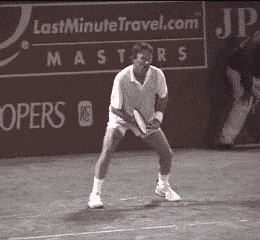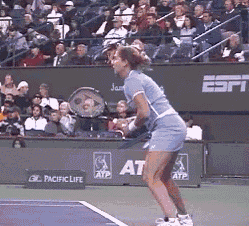|
TennisOne Lessons
If these champions of serve and volley generated few followers there must be other forces at work driving the evolution of game. It's not enough to say that the history of tennis is shaped by the style of reigning champions. Let's examine how changes in game set off an evolutionary sequence that has much to do with the current state of the modern pro game. Evolution of Tennis StrokesIt is a given that tennis has seen substantial changes over time. These changes include shifts in general stroke methodology preference and dominance, (from one-handed backhands to two, slice groundstrokes to topspin, touch and finesse to power), to changes in playing strategies, (from chip-and-charge to serve-and-volley to baseline supremacy). In addition, changes in manufacturing technology—from shoe improvements to innovative racquet construction and design—have to be considered as elements in the mix. Arguably the greatest observable change in tennis, however, has been the pervasive shift from the use of one-handed backhands to two. In fact, I can’t think of another sport that has seen such a radical change in a major technical component. Perhaps the closest comparison would be the crossover putting grip now used in golf, or the historical "Fosbury Flop" which literally changed the direction of high jumping when Dick Fosbury first went over the bar upside down and head first in 1969. It is interesting in observing the evolution of the two-handed backhand, that the stroke did not gain any significant attention until the early 1970’s. It took nearly 100 years—from the time tennis was invented—before the stroke gained acceptance! Considering sports that utilize similar two-handed swing patterns, namely golf, baseball, cricket and hockey have been around for essentially as long as tennis has, it is amazing that top players did not emerge with the shot until specifically the 1970’s. Those leading the transformation of the two-handed backhand include Bjorn Borg and Jimmy Connors on the men’s side, and Chris Evert and Tracy Austin on the women’s. However, it would take essentially another two decades before the two-handed backhand would be seen as a dominant choice of both men and women’s pro tours. Of course, it stands to reason that if very few players used the stroke in the first place, that even fewer pros would be inclined to teach the stroke to beginners. Today, most all players who take lessons are introduced to the stroke due to the recognized inherent qualities that two-hands create when learning the backhand. (More on the evolution of the two-handed backhand in Part 3 of this series.) And with so many role models executing the stroke today, it is easy to see how the current trend is continually being fueled! But how did this transition occur and why was it so long in the making?
At the early stages of the transition, it's hard to argue that pivotal players such as Bjorn Borg or Chris Evert developed the two-hander from any purposeful motive other than circumstance. Borg adapted his backhand from the slap shot he used in playing hockey as a child. Evert was actually discouraged from hitting the two-hander by her father/coach Jimmy Evert! Connors was considered a maverick from the wrong side in St. Louis, with a "woman's game" taught to him by his mother and grandmother. So did the transition occur through the emulation of these players? Partially yes. But another overlooked factor was a new recognition of the value of greater tospin. And ironically, the value of topspin in the modern game was first demonstrated by a champion playing in a completely different style, the great Rod Laver. That's right, ultimately we can look back to the development of Rod Laver’s heavy topspin groundstrokes as a precursor of the two-handed backhand. Although Laver, obviously, hit a one-handed backhand, his formidable use of topspin on both sides inspired the use of such spin in the subsequent strokes of those who followed. And this led to the natural discovery that for the majority of players, producing topspin on the backhand was far easier with two-hands. Bud Collins, in his book Bud Collins’ Tennis Encyclopedia, said this about Laver’s influence: “Although others had used topspin, Laver may have inspired a wave of heavy-hitting topspin practitioners of the 1970’s such as Bjorn Borg and Guillermo Vilas. The stroke became basic after Laver.” If the identification of topspin was a desirable attribute for players looking for greater stroke effectiveness, then certainly science, and more specifically physics, will have played a critical role in guiding the evolution of the game. Consciously or otherwise, players—beginning with Laver, perhaps—began exploring ways to induce greater power through added topspin. This exploration certainly can explain the rise of more topspin-orientated grips such as semi-western and full western grips on the forehand and the use of the Eastern backhand grip for one-handed backhands. (And the influx of two-handed backhands as stated above.) After the two-hander was widely established, yes, the importance of top players as role models contributed to it's dominance. But at the critical transition point, this change had little to do with the influence of any given champion. The effectiveness of topspin, in and of itself, initiated a broad based technical change that had nothing to do with modeling the player who had first demonstrated it's superiority. In fact this transition to topspin had repercussions far beyond the rise of the two-handed backhand. Once established, this evolutionary advance developed it's own logic and momentum. The transition to two hands can also help explain the rise of topspin-orientated forehand grips such as semi-western and full western grips, as well the more extreme Eastern backhand grips used for one-handed backhand topspin. Recognizing that greater topspin not only created greater downward arc into the court on groundstrokes and thus more potential power, players began to utilize this same spin to create greater angles on their groundstrokes, opening up the court like never before. Inside-out forehands and backhands, severe crosscourt angles, and dipping angled passing shots are now a regular commodity among most top players.
The SliceWe can actually trace the same evolutionary logic in the decline of the slice. If there were any shot that has remained un-compromised and essentially unchanged in terms of form, power, effectiveness and control, over the historical context of tennis strokes, it would have to be the forehand and backhand slice. But the move to topspin and the two-handed revolution evolution exposed the physical and bio-mechanical limits of the slice, reducing it's effectiveness in the modern player's arsenal. The slice proved incapable of further evolution due to limits in the actual physics of the stroke. Unlike its topspin counterpart, the slice has inherent bio-mechanical limitations based on physical laws of motion. Watch pros today when they hit the slice. You will never see a pro attempt to hit the slice with the amount of force exerted as with a topspin groundstroke! Since slice or underspin actually causes the ball to rise, the slice stroke can only be hit so hard before it can no longer possibly land in the opponent’s court. On the other hand, topspin, in theory, can be hit harder and harder, as long as the amount of topspin counters the forward velocity of the ball. Many of the past champions of tennis have acknowledged that this demarcation between groundstroke technique represents the greatest historical change in tennis. The ServeHere in my opinion we can see yet a third independent factor contributing to the evolution of the game; the changes in racquets. Perhaps more than any stroke, the serve has witnessed changes in speed and effectiveness more recently due to the advent of technologically advanced equipment. Although there have been past notable tennis champions who possessed relatively powerful serves, (Bill Tilden, Pancho Gonzalez, and Lew Hoad of historical significance, and Stan Smith and Roscoe Tanner a short generation ago), there seems to be much greater service dominance by a plethora of players in today’s modern game. Today, we even see women professionals serving at 120 miles per hour…a feat unimaginable twenty years ago! It raises the question of just how good the players of the past could have served if they were afforded today’s space-age racquets. Obviously, greater strength training, conditioning and, perhaps conquering psychological barriers, have contributed to the increases we have seen in the modern serve as well.
The Two-handed ForehandSo what's on the horizon? Can we anticipate any further major developments in the evolution of how the game is played? One intriguing possibility is the two-handed forehand. Although it's currently little more than a curiosity on the pro tour, the two-handed forehand is making revolutionary strides among the junior ranks similar to those of the two-handed backhand back in the 1970’s. Although nowhere near as prevalent as the two-handed backhand, (because of the still-favorable mechanics for many players executing decent topspin with only one hand), the two-handed forehand is nevertheless growing in popularity. Even as Pancho Segura showed what a weapon it could be back
in the 1940’s, it didn’t raise any eyebrows until the 1990’s when Monica
Seles utilized the stroke in becoming the number one women’s player in the
world in 1991. Even then, it seemed more of a fluke-like occurrence, with
few players—especially men—looking to try the shot. Even today, few tennis
instructors know how to teach the shot with confidence, precision, and
proper mechanics. However, now with Jan Michael Gambill demonstrating its
use on the men’s professional tour, and a significant crop of talented
juniors on the rise using the stroke, I feel the two-handed forehand is destined
to make its mark on the evolving game of tennis.
|
Last Updated 5/1/02. To contact us, please email to: webmaster@tennisone.com TennisONE is a registered trademark of TennisONE and SportsWeb ONE; Copyright 1995. All rights reserved. |
|||||||








 Your comments are welcome. Let us know what you think about this article by
Your comments are welcome. Let us know what you think about this article by